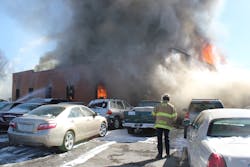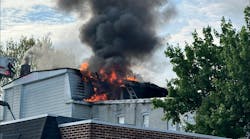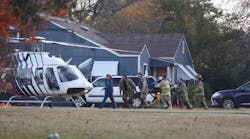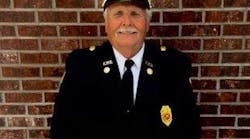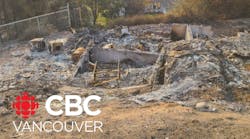In January 2014, the Greensboro, NC, Fire Department (GFD) experienced an extreme close call when a roof collapsed during a large fire at an auto shop. The fire resulted in one critical injury and four less-serious injuries; however, the fire had the potential to result in six fatalities.
The leadership at the GFD has shared their story through this column so that all firefighters can learn from what they experienced. In the April issue, we looked at the incident overview, the initial response, interior attack and what went wrong. In the May issue, we reviewed the incident’s warning signs and the rescue operations that ultimately prevented multiple line-of-duty deaths. This month, we’ll review some operational and tactical considerations as well as lessons learned from the incident.
Review of the fire
On Jan. 30, 2014, the GFD responded to a fire at 811 South Elm St. Initially reported as a vehicle fire inside of a business, the fire had already spread within the structure before the first fire department unit arrived. Upon arrival, firefighters began to attack the fire and search the structure to ensure that all occupants had evacuated and prevent additional fire spread.
A structural collapse occurred approximately 9 minutes and 40 seconds after the arrival of the first GFD unit. Six firefighters were inside of the structure when the collapse occurred. Three firefighters, although injured, were able to escape to the exterior, and two firefighters who were close to the building entrance were not trapped. The captain of the first unit to arrive was trapped under the debris. Fortunately, firefighters were able to lift the debris off the captain and he was removed from the building.
Guilford County EMS transported the captain and the other injured firefighters to the hospital. Most of the injured firefighters have been or are expected to return to full duty after recovery from their injuries. The captain is on light duty with a mission to teach the GFD members about this incident.
Consider the situation
It is important to point out that even as the GFD was faced with a rapidly evolving, low-frequency/high-risk situation, everyone involved in the incident performed their assigned duties at a high standard and as they had been trained. But there are important lessons to be learned from this incident—lessons that should significantly reduce the risk of a similar occurrence in the future.
If the incident were to be summed up in a simple overview, it would be that inadequate size-up and inappropriate strategy resulted in firefighters being under the roof when it collapsed. Fortunately, Fire Captain Thomas Suddarth was saved from a situation that very likely would have been fatal, if not for five critical factors:
- A well-executed mayday procedure
- A well-executed rapid-intervention crew (RIC) activation and rescue operation
- Sufficient fire department resources in this area of Greensboro
- The immediate availability of EMS at the incident scene
- Excellent medical care
In addition, the members who self-extricated utilized techniques that they had learned and practiced at the Training Academy. Without this training, there could have been at three additional members trapped in a location that was not immediately evident.
Note: While it’s easy to read the following and refer it solely to the GFD, please consider your own department and determine where it stands based upon what the GFD experienced and the recommended changes they are making.
Let’s now review several areas that have been identified for suggested change at the GFD. Additionally, I have provided observations that are not necessarily specific to this fire, but relatable to many incidents. We can all use this information as comparison to our own departments as a learning opportunity.
Reaction by Command
The message reporting an imminent roof collapse should have prompted an immediate evacuation of all personnel from the interior of the building. This should have been a reflex action on the part of the incident commander (IC) and safety officer; however, such reflexes are only developed through experience and/or practice. The rapid sequence of events demonstrates that there was no time for analysis or communication with units to try to determine their position in relation to the potential collapse zone.
Size-up and strategy training
A complete 360-degree structural evaluation is now mandated when possible and as promptly as conditions permit. Further, the GFD is conducting additional training on size-up and determination of the appropriate strategy for a variety of situations. This training incorporates:
- The IAFC Safety, Health and Survival Section’s Rules of Engagement for Structural Firefighting
- Reading smoke
- Situational awareness
- Risk-benefit analysis
- Command simulations based on increasingly challenging/rapidly changing situations
- Analysis of actual incidents from Greensboro and other fire departments
A systematic size-up should be emphasized in policy revisions. Size-up report needs are outlined so that all companies arriving at a fire will address the same basic issues, such as:
- Building size
- Building height
- Occupancy type
- Describe the problem (e.g., smoke/fire conditions, location)
- Initial Incident Action Plan (IAP)—tasks, location, objective(s)
- Declaration of the strategy—offensive or defensive
- Identify water supply
- Assume/name command and your physical location at the scene
Size-up should be practiced and applied to every fire response, from automatic fire alarms to reported fires, in order to create a disciplined process.
Initial ICs must invest the time required to conduct an appropriate size-up. In most cases, an adequate size-up can be conducted within 30 to 60 seconds and will allow you to develop a more effective action plan. When confronted with a more challenging situation, the discipline of a systematic size-up should prompt the initial IC to consider all of the key factors, particularly firefighter survival, before committing to an action plan.
While it may seem that you have to operate quickly—and in some cases you certainly do—the operation can’t start until there is a plan! The size-up and report provides that plan.
All fire departments should invest in a comprehensive training program for company and command officers to support the ongoing development of incident management skills. Well-planned simulation exercises allow officers to gain experience managing a variety of challenging situations, recognizing critical indicators and making appropriate decisions.
Pre-fire planning
Pre-fire planning should provide critical information and risk factors for our use before and upon arrival at the fire. Any critical information should be immediately transmitted to responding units, and the full plan should be available to the IC.
At the time of the auto shop fire, the existing pre-fire plan information was accessible via the mobile computers in GFD vehicles; however, the process for accessing this information was cumbersome. Critical information, such as the presence of an unprotected steel truss roof, should be automatically presented on the mobile data terminal as a warning message.
A well-prepared pre-fire plan (for this fire) would identify issues such as an unprotected steel truss roof as a critical safety concern and also includes an accurate site plan and interior floor plan of the building. The lieutenant of Ladder 11 indicated that the roof collapse was in “the middle building” based on his perception that the building was divided into three sections by interior masonry walls. The building was actually divided into two sections by an interior brick wall. The IC may have been able to recognize this discrepancy if he had been provided with an accurate pre-plan of the building.
In this case, the GFD is enhancing its process of developing pre-fire plan information and placing a priority on capturing critical factors for properties that involve high risks and/or unusual challenges. GFD companies will now conduct annual visits to all commercial structures within their first-due territory. Fire departments should invest in a software system to manage the pre-fire plan information, including drawings and photographs. Wherever possible, the pre-fire plans should be integrated with the existing GIS capabilities and interfaced to the mobile data terminals so that the information is immediately available when units are dispatched to a location for which a pre-fire plan has been developed. Note: For small departments that cannot afford data-driven systems, the simplest system can be created by first-due companies working with paper in three-ring binders. It can be done!
Staffing and first-alarm response
As we’ve discussed for years in this column, it really all comes down to staffing. We can have the best intentions in mind, but if we don’t have the people and the resources, we cannot be as successful as we envision.
The availability of a sufficient number of properly staffed companies was a significant factor in this incident, as is the case with many other departments’ close calls. At the call Greensboro fire, there were 25 personnel on the first alarm and 56 on the second and third alarms, for a total of 81.
The GFD is continuing to improve its staffing levels to ensure a standard level of response, by working to increase staffing for all ladder companies to meet industry standards (NFPA 1710). Currently, five of the GFD’s 11 ladder companies are staffed with four personnel (increased staffing on two of the five occurred within this fiscal year). The remaining six are staffed daily with three. However, the department is on the verge of increasing the staffing on two additional ladders as of July 1. Additionally, there are plans to staff the last four ladders with four personnel in the near future.
With this in mind, consider these questions related to your staffing needs:
- What do you send to your first alarm?
- How is it determined?
- Do you have adequate staffing to accomplish the required tasks?
- What are the tasks you want performed and how quickly?
- Do you have the resources to do that?
- Will you also have enough personnel on the first alarm to handle whatever might go wrong?
This applies before the fire as well as when turning out and arriving. We can plan for this well before the fire!
Command officer and staff response
The response of additional on-duty chief officers and training staff proved to be advantageous at this incident. Most of these individuals self-dispatched when they heard the initial radio traffic indicating a working fire.
The incident occurred at a time when all of the on-duty battalion chiefs (BCs) were en-route to a meeting and all of the training staff members were immediately available to respond. These resources would not have been available if the incident had occurred outside regular work hours for staff personnel.
All fire departments, regardless of size, should ensure that all available command officers are immediately notified of working fires (or reported working incidents) and other significant incidents. Additional command officers should be designated to respond to fill positions in the command structure.
Many departments only have one command officer on duty; as such, one option to consider is a system we use in our area called “Mini IMAT Teams.” IMAT stands for Incident Management Assistance Team. Simply put, not unlike a football team, members of the “coaching staff” operating outside of the field use the information they see on the field to determine how they can win. The obvious difference is that our personnel are not playing; they are working, often at high risk.
Like most in our area, at my department—Loveland-Symmes (a suburb of Cincinnati)—there is a shift commander (district chief) on duty who responds in a command vehicle to function as the IC, exactly like a BC in most cities. We made some changes several years ago due to the numerous required roles that must be performed to provide support to the IC, as well as support and supervision to the firefighters. For instance, at a fire involving a single-family dwelling, other roles to be considered include division supervisors, accountability, incident safety and a chief’s aide to assist in communications.
In many cases, our IC did all of these functions, and many of you can relate as you have, too. We decided to take the automatic mutual-aid box alarm concept and expand it into assignments to include additional chief officers from other departments on the initial dispatch of the first-alarm assignment.
The Mini-IMAT Teams concept consists of mutual-aid chief officers from neighboring communities who have been programmed into the dispatch system. In our alarm assignments, upon the receipt of a verbal report of visual smoke or fire of any kind within a structure, the dispatcher follows the computer-aided dispatch (CAD) assignment that now includes four additional automatic mutual-aid chiefs from outside the first-due department’s jurisdiction.
Some have asked why we don’t use company officers in these roles. We don’t do that because we want to maintain company integrity and company supervision, and our company officers are the most qualified to handle their companies.
Communications system
Fire communication centers, their personnel and leadership can really make or break an incident. Dispatching is not simply setting off tones but also an integrated and critical aspect of the emergency, from the first 9-1-1 call until the last company returns to quarters.
The analysis of this fire identified several concerns with the Guilford Metro 9-1-1 dispatch and communications systems. The existing orientation of the Communications Center is directed primarily toward receiving 9-1-1 calls from the public and dispatching the appropriate resources to emergency incidents. After this fire analysis, it was identified that the dispatch center does not provide adequate support for the operational requirements of a metropolitan fire department.
At the time of this incident, the Communications Center did not monitor the tactical talk groups that are used by the units operating at the scene of a structure fire or any other type of incident that involves multiple units. The operator assigned to fire operations only responded to radio traffic from the IC and was generally unaware of activity that was occurring at the incident scene. The same operator was responsible for monitoring traffic from several active incidents on the same talk group.
Since this incident, the Communications Center has instituted several changes. For example, a working structure fire will now have a dedicated dispatcher assigned to the assigned fireground tactical channel.
9-1-1 call-taking
The recordings of telephone calls to 9-1-1 indicate that the call-taker had all of the essential information to dispatch the initial assignment within 20 seconds after the first call was answered; however, the initial dispatch did not occur until 90 seconds after the call was received, exceeding the 60-second objective for call processing at the Communications Center.
The call-taker initially entered the information as a vehicle fire, although the caller had stated that the burning vehicle was inside a building. This resulted in the initial dispatch of Engine 11 for a vehicle fire. It is possible that the call-taker did not hear this statement due to the caller’s accent and excited state. The dispatch was upgraded to a structure fire assignment, and the brief delay in upgrading the assignment had no impact on the subsequent events.
A proprietary call-entry process used by the Communications Center requires the call-taker to ask a series of pre-programmed questions and enter the answers into the CAD system. It is my opinion, along with those who evaluated this fire, that these call-taking questioning systems are often cumbersome, inflexible and time-consuming. The public and firefighters may be better served by trained and experienced operators who know the important questions to ask for different situations—and what information should be transmitted to responding units.
In this case, the call-taker was on the line with the caller for 4 minutes and 18 seconds; the call ended at approximately the time Engine 11 was stopping at the hydrant to lay a supply line to the fire. It is evident that the call-taker was following the steps of the prescribed call-taking system, despite some of the questions being irrelevant or unnecessary.
Fire chiefs should ensure that their communication center is handling calls in a manner that best benefits those having the emergency and the firefighters responding. Many departments rely on regional communication centers to provide service, which is great. It is critical, however, that the call-processing system ensures a rapid dispatch along with critical and timely transfer of information.
Radio operations
In this case, if an incident is a structure fire, a tactical talk group is also assigned at the time of dispatch. While en route, all of the responding units also monitor and communicate with each other on this tactical talk group. After arrival, the IC uses the tactical talk group to communicate with the units that are on the scene and must either switch back to the Fire Operations talk group or use a second radio to communicate with the Communications Center.
The switching and simultaneous monitoring of multiple talk groups creates the risk of missing critical messages or losing contact with units that are involved in high-risk situations. This is a particular problem for an initial IC who is operating with a portable radio or for a BC who is alone in a command vehicle. The second-arriving BC routinely assumes a support position in the command vehicle and manages communications on the Fire Operations talk group.
The tactical talk groups are arranged in pairs, with only the even-numbered talk groups being initially assigned to incidents. This is intended to leave the next sequential odd-numbered talk group immediately available for use at the same incident. In the event of a mayday or some other situation that requires units to switch to a different tactical channel, the alternative channel should be “one click up” on the channel selector.
The South Elm Street incident was initially assigned to GCTAC14, which should have reserved GCTAC15. A simultaneous incident was assigned to GCTAC16, which should have reserved GCTAC17. When Car 12 called on the Fire Operations channel for two additional tactical channels to be assigned to the incident, the logical choices would have been GCTAC15 and GCTAC18, which also would have reserved GCTAC19.
There was a delay of 97 seconds before Fire Operations assigned GCTAC18 and GCTAC24, after prompting from the IC. This created confusion because some of the units on the scene had already switched to GCTAC15 in response to the mayday. Since this incident, another change implemented by the Communications Center is to move up or “bump” another call (if less significant) to a higher channel, thus freeing the needed channels for those units operating on the fireground with the mayday occurrence.
Confusing? Sure it is. Conduct a drill at your department to ensure that every member (and all dispatchers) easily understand the purpose, use and accessibility of fireground channels. Procedures for assigning talk groups must be as simple as possible with the least amount of steps required by units in the field.
While these issues caused brief confusion at the Greensboro fire, the impact on the operation was not severe. Everyone involved managed to adapt to the situation without consequences.
Radio straps
In the course of the Greensboro fire, at least one endangered firefighter’s portable radio was ejected from his turnout gear and lost as a result of the roof collapse. As a result, the use of the radio strap is now mandated in the GFD to ensure that continuous fireground communications and the ability to transmit emergency messages are maintained at all times between Command and operating units.
During a mayday or rescue event, sustaining communication is critical to the operation and to improving the survivability of a downed firefighter. Had it not been for the presence of other crewmembers and their radios, the ability to transmit a crisis situation would have been lost, and the need for a rapid-intervention response would have remained unknown. Radio straps help ensure the radio stays with you.
Taking care of our own
In the immediate aftermath of the incident, the management and membership of the GFD did an outstanding job of supporting the firefighters involved, their families and the rest of the GFD family. This fire was a near-death experience for a number of firefighters, and these situations weigh heavily on the minds of other firefighters on the scene, firefighters who were not working but face the same dangers in their work, and the families of these firefighters.
The GFD took the time and made the effort to provide information to the fire department family, to stand by the side of the injured firefighters, to provide food to those in need, to avail the services of several chaplains and to provide debriefing services for firefighters and their families. Other departments that had suffered traumatic events also stood by the GFD in their time of need.
Conclusion
My sincere appreciation to GFD Chief Greg Grayson and Captain Thomas Suddarth for their outstanding cooperation and assistance in preparing this three-part article. Equally, our thanks go out to Captain William Shane Boswell and firefighters Matthew Clapp and Bryan Bachemin who also sustained injuries.
Additionally, a special thanks to Kevin Roche and Gordon Routley from FACETS Consulting. FACETS Consulting was retained by the GFD to provide a thorough analysis of this incident, and this article is based upon the findings from that report.
The fact that the leadership of the City of Greensboro and the leadership of the GFD chose to get an outside review of this incident, and have allowed me to write about it, demonstrates a commitment to the facts and sharing their lessons learned.
